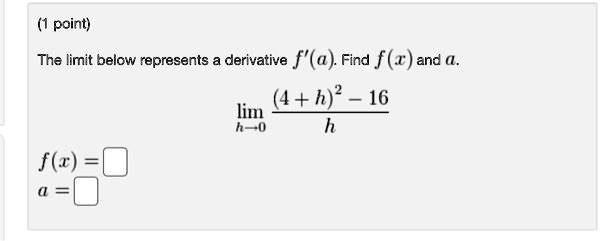
The Correct Answer and Explanation is:
The limit given is:
limh→0(4+h)2−16h\lim_{h \to 0} \frac{(4 + h)^2 – 16}{h}
This expression fits the definition of the derivative at a point, which is:
f′(a)=limh→0f(a+h)−f(a)hf'(a) = \lim_{h \to 0} \frac{f(a + h) – f(a)}{h}
In the given limit, the numerator is (4+h)2−16(4 + h)^2 – 16. Notice that 16 is 424^2, so we can recognize that f(a+h)=(4+h)2f(a + h) = (4 + h)^2 and f(a)=16f(a) = 16. This means a=4a = 4, and since the function squared the input, we deduce that f(x)=x2f(x) = x^2.
Correct answers:
- f(x)=x2f(x) = x^2
- a=4a = 4
Explanation
To determine the function f(x)f(x) and the value aa from the limit expression, begin by identifying the structure. The given limit has the form used to define the derivative of a function at a point. The general form is limh→0f(a+h)−f(a)h\lim_{h \to 0} \frac{f(a + h) – f(a)}{h}, where ff is a function and aa is the specific point of evaluation.
In this expression, f(a+h)f(a + h) appears to be (4+h)2(4 + h)^2, and f(a)f(a) is 16. Observing that 42=164^2 = 16, it becomes evident that a=4a = 4. From f(a+h)=(4+h)2f(a + h) = (4 + h)^2, we infer the general function rule is f(x)=x2f(x) = x^2, since substituting x=4+hx = 4 + h recovers the form f(a+h)f(a + h).
To verify this, apply the function definition and use the difference quotient:
f(4+h)−f(4)h=(4+h)2−16h\frac{f(4 + h) – f(4)}{h} = \frac{(4 + h)^2 – 16}{h}
Expand the square in the numerator:
(4+h)2=16+8h+h2(4 + h)^2 = 16 + 8h + h^2
Subtract 16:
8h+h28h + h^2
Divide the entire expression by hh:
8h+h2h=8+h\frac{8h + h^2}{h} = 8 + h
Taking the limit as h→0h \to 0, we find:
f′(4)=8f'(4) = 8
This confirms the function and the point of differentiation.
